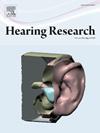Does simple impedance reflect intrascalar tissue in the implanted cochlea?
IF 2.5
2区 医学
Q1 AUDIOLOGY & SPEECH-LANGUAGE PATHOLOGY
引用次数: 0
Abstract
A potential threat to the long-term preservation of electrical and acoustical hearing in cochlear implant patients is the development of fibrous tissue and bone in the scala tympani. Simple impedance measures (impedance = voltage/current; Z = V/I), which are commonly used as a non-invasive test of implant integrity, might also be useful for monitoring the environment of the implanted cochlea. Increases in impedance might reflect growth of tissue that impedes current flow. Subsequently then in this study in guinea pigs, impedances for sinusoidal and pulsatile stimuli were measured with cochlear implants for up to 21 months and compared to histology at termination. Histology revealed variable distributions and amounts of scala tympani tissue near the primary measurement electrode. Impedances measured in the first 4 months after implantation increased and decreased over time, suggesting they were influenced by factors other than, or in addition to, tissue growth within the scala tympani. The magnitude of change in impedance for the sinusoidal stimuli was a moderate, statistically significant, predictor of the percentage of new bone and not fibrous or the total tissue in the long term. The extent of new bone was associated with long-term trends of increasing impedance. End-point impedances were highly correlated between bipolar and monopolar sinusoids, and monopolar sinusoids and pulses. Impedances for both stimuli and configurations showed that the amount of fibrosis was not predicted by impedance, but the presence of new bone was. The results should be helpful in determining the underlying causes of functional changes following cochlear implantation.
单纯阻抗是否反映植入耳蜗内的肌内组织?
中耳膜纤维组织和骨骼的发育是影响人工耳蜗患者长期保持电听力和声学听力的潜在威胁。简单的阻抗测量(阻抗=电压/电流;Z = V/I),通常用作植入体完整性的非侵入性测试,也可能用于监测植入耳蜗的环境。阻抗的增加可能反映阻碍电流流动的组织的生长。随后,在这项豚鼠研究中,在长达21个月的耳蜗植入中测量了正弦和脉冲刺激的阻抗,并与终止时的组织学进行了比较。组织学显示,在初级测量电极附近,鼓膜组织的分布和数量不等。在植入后的头4个月测量的阻抗随着时间的推移而增加和减少,这表明它们受到鼓膜内组织生长以外的因素或其他因素的影响。正弦刺激的阻抗变化幅度是一个适度的,统计上显著的,预测新骨的百分比,而不是长期的纤维组织或总组织。新骨的范围与阻抗增加的长期趋势有关。终点阻抗在双极正弦波和单极正弦波以及单极正弦波和脉冲之间高度相关。刺激和结构的阻抗都表明,阻抗不能预测纤维化的数量,但可以预测新骨的存在。结果应有助于确定人工耳蜗植入术后功能改变的潜在原因。
本文章由计算机程序翻译,如有差异,请以英文原文为准。
求助全文
约1分钟内获得全文
求助全文
来源期刊

Hearing Research
医学-耳鼻喉科学
CiteScore
5.30
自引率
14.30%
发文量
163
审稿时长
75 days
期刊介绍:
The aim of the journal is to provide a forum for papers concerned with basic peripheral and central auditory mechanisms. Emphasis is on experimental and clinical studies, but theoretical and methodological papers will also be considered. The journal publishes original research papers, review and mini- review articles, rapid communications, method/protocol and perspective articles.
Papers submitted should deal with auditory anatomy, physiology, psychophysics, imaging, modeling and behavioural studies in animals and humans, as well as hearing aids and cochlear implants. Papers dealing with the vestibular system are also considered for publication. Papers on comparative aspects of hearing and on effects of drugs and environmental contaminants on hearing function will also be considered. Clinical papers will be accepted when they contribute to the understanding of normal and pathological hearing functions.
 求助内容:
求助内容: 应助结果提醒方式:
应助结果提醒方式:


